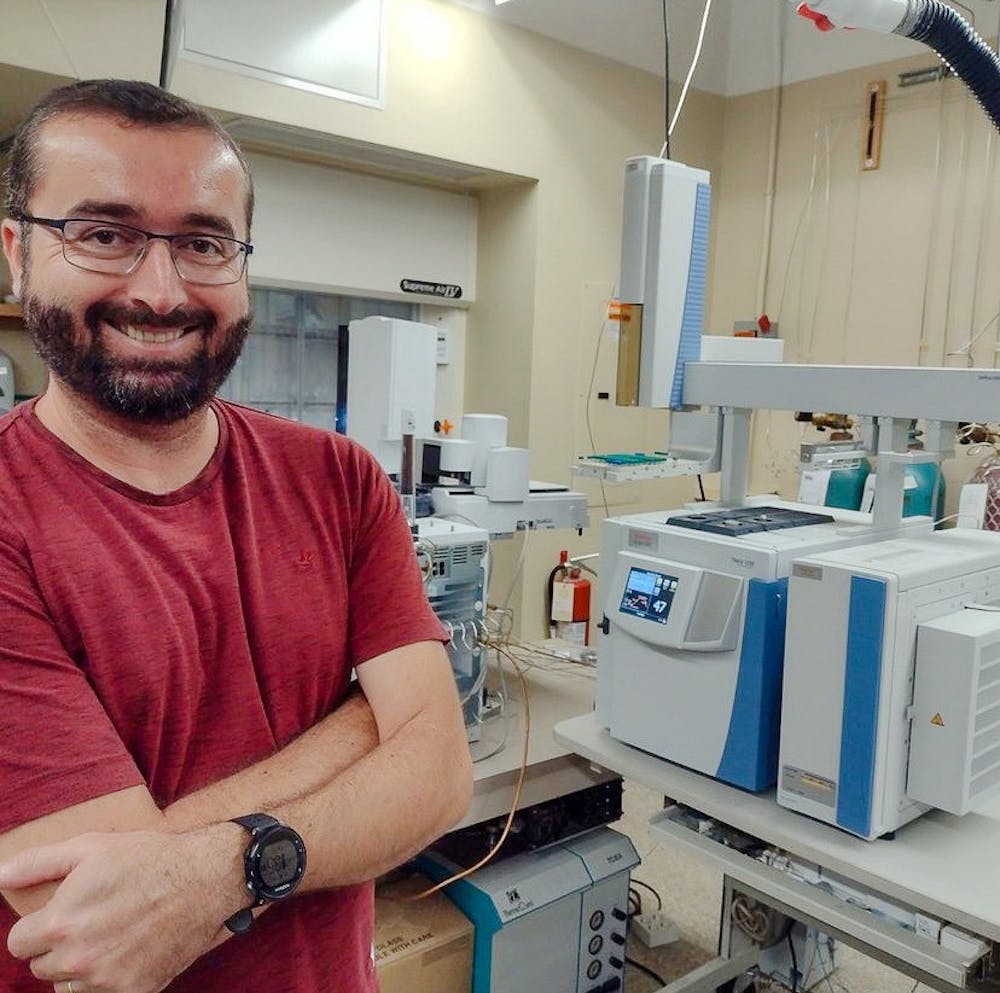“Are you procrastinating on your midterms and looking for the perfect little silly distraction?” begins an Oct. 20 Instagram post from the Department of Earth, Environmental and Planetary Sciences. The department is holding a naming competition on social media for two mass spectrometers, asking followers to suggest possible names in the comments section of the post.
A mass spectrometer is an “analysis tool that separates ionized molecular fragments based on their mass,” said Marcelo Alexandre, facility manager of the Organic Geochemistry Facility, where the mass spectrometers are located. Researchers use the machine to “analyze the isotopic makeup of individual compounds and better understand past climates,” he added.
One of the machines, referred to on social media as Mass Spectrometer A, is being named through the DEEPS Instagram account, @Brown_Geo_Sci,. The 17-year-old “groovy machine … prefers to work on CO2 analysis and carbon isotope ratios,” reads the caption of an Oct. 25 Instagram post. “It also enjoys coloring books, crocheting mushrooms and listening to the Beatles, Destiny’s Child or the @ems.femmes,” the caption continues, referencing a student jazz band.
The other machine, referred to as Mass Spectrometer B, is in its second year on campus and is being named through the DEEPS Twitter account, @BrownGeoSci. This machine primarily deals with hydrogen isotope measurements and listens to classic rock and K-pop, according to an Oct. 25 DEEPS Twitter post.
The primary goal of the naming competition is to promote social media engagement with the department, according to Mae Jackson, a communications specialist and organizer of the DEEPS social media accounts.
“We recognize that Brown University students use social media a lot — it’s a great way to see what’s happening in the student body,” Jackson said. “As that space grows, we’re able to do more public education.”
She added that the contest will close submissions when the department’s Instagram account reaches 450 followers and its Twitter reaches 1,000 followers.
Jackson noted that another goal of the naming competition is to help researchers differentiate between the machines. They “are very similar and (occupy) the same space,” she said. “When some of our researchers want to use one or the other, it can get confusing as to which one they want.”
Since Mass Spectrometer A and Mass Spectrometer B differ in age but are the same model of machine, researchers currently refer to them as “old” and “new,” according to Alexandre, who is responsible for maintaining the spectrometers.
Jackson said that after submissions close, she and the rest of the social media account team will filter through the submissions, pick their favorites and open final voting to the public via a Google Form.
Although these machines will be the first spectrometers to be named at Brown, it is not uncommon for researchers to name other highly specialized pieces of technical equipment, Jackson said, adding that one of the high-pressure devices in Associate Professor of Earth, Environmental and Planetary Sciences Stephen Parman's lab is named “Bertha.”
Submissions commented on the Oct. 20 Instagram post announcing the contest currently include “The Ionizer,” “Inspectrometer Gadget” and “Massy McMassFace.”
Caleb Moran ’25, an applied math and computer science concentrator, proposed the name “I-So-Dope.” He explained the name is “a pun on isotope, which is a chemical property that mass spectrometers can analyze.”
“I just had a little brainstorm and I was like, ‘I-So-Dope kind of sounds like isotope,’ ” he added.
The University currently has eight mass spectrometers, four of which are under Alexandre’s supervision. These other mass spectrometers are not part of the naming competition, as they are all different models from Mass Spectrometers A and B and are therefore not confused by researchers, he added.
Alexandre said that when he first came to Brown in 2003 as a visiting PhD student, there was only one mass spectrometer in DEEPS, which was located in Professor of Earth, Environmental and Planetary Sciences Yongsong Huang’s lab. “That’s where I started to know mass spectrometry,” Alexandre added.
The mass spectrometers can play substantial roles in student research projects. Alex Wilk ’23, who is involved in a project in Chair and Professor of Earth, Environmental and Planetary Sciences James Russell’s lab, uses the machines to analyze changes in vegetation and moisture.
“A variety of paleoclimate methods rely on understanding ratios of different stable isotopes,” Wilk said.
Natalie Chang ’24 previously used the spectrometers for a research project on paleoclimates in Assistant Professor of Earth, Environmental and Planetary Sciences and Environment and Society Daniel Ibarra’s lab last summer.
On Instagram, Chang submitted the name “Specky with the good hair” followed by an emoji of fingernails being painted with pink polish. Wilk liked and commented in support of the submission.
Both Chang and Wilk appreciate the atmosphere that the contest seeks to foster. “I think it’s a fun way to build community and connect … undergraduate researchers, faculty and grad students who are all using the same machine,” Wilk said. “It's a great way to really lighten up what can be … just a lot of technical study and scientific terminology.”
Corrections: A previous version switched the follower counts of DEEPS' Instagram and Twitter accounts and used an out of date title for Mae Jackson. The Herald regrets the errors.





